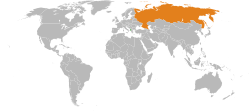Albania–Russia relations
 |
|
|
Albania |
Russia |
|---|---|

|
|
| Total population | |
|---|---|
| (1,300) | |
| Regions with significant populations | |
| Moscow, St. Petersburg, Stavropol Krai, Azov Sea region, Krasnodar Krai | |
| Languages | |
| Albanian, Russian, Serbian | |
| Religion | |
| Eastern Orthodox Church | |
| Related ethnic groups | |
| Russians, Albanians in Serbia, Albanians in Sweden |
Albanian–Russian relations are foreign relations between the Republic of Albania and the Russian Federation. The establishment of diplomatic relations between Albania and the Soviet Union happened on April 7, 1924. Both countries were also allies in the Warsaw Pact.
Albania has an embassy in Moscow. Russia has an embassy in Tirana.
Both countries are full members of the Organization of the Black Sea Economic Cooperation, Organization for Security and Co-operation in Europe, Organisation of Islamic Cooperation (Albania is a member, while Russia is an observer state), and the Council of Europe.
Because the Soviet Red Army never entered Albania, the Albanians liberated their own nation. Albania had developed very good relations with Yugoslavia, and especially their post-war relations were very good.
In February 1949, Albania gained membership in the communist bloc's organization for coordinating economic planning, the Council for Mutual Economic Assistance (Comecon). Tirana soon entered into trade agreements with Poland, Czechoslovakia, Hungary, Romania, and the Soviet Union. Soviet and East European technical advisers took up residence in Albania, and the Soviet Union also sent Albania military advisers and built a submarine installation on Sazan Island. After the Soviet-Yugoslav split, Albania and Bulgaria were the only countries the Soviet Union could use to funnel matériel to the communists fighting in Greece. What little strategic value Albania offered the Soviet Union, however, gradually shrank as nuclear arms technology developed.
...
Wikipedia
